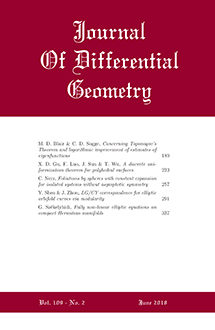Abstract
For a harmonic map $u : M^3 \to S^1$ on a closed, oriented $3$-manifold, we establish the identity\[2 \pi \int_{\theta \in S^1} \chi (\Sigma _\theta) \geq \frac{1}{2} \int_{\theta \in S^1} \int_{\Sigma_\theta}\left( {\lvert du \rvert}^{-2} {\lvert \mathit{Hess} (u) \rvert}^2 + R_M \right)\]relating the scalar curvature $R_M$ of $M$ to the average Euler characteristic of the level sets $\Sigma_\theta = u^{-1} {\lbrace \theta \rbrace}$. As our primary application, we extend the Kronheimer–Mrowka characterization of the Thurston norm on $H_2 (M; \mathbb{Z})$ in terms of ${\lVert R^{-}_M \rVert}_{L^2}$ and the harmonic norm to any closed $3$-manifold containing no nonseparating spheres. Additional corollaries include the Bray–Brendle–Neves rigidity theorem for the systolic inequality $(\min R_M) \mathit{sys}_2 (M) \leq 8\pi$, and the well-known result of Schoen and Yau that $T^3$ admits no metric of positive scalar curvature.
Citation
Daniel L. Stern. "Scalar curvature and harmonic maps to $S^1$." J. Differential Geom. 122 (2) 259 - 269, October 2022. https://doi.org/10.4310/jdg/1669998185
Information





